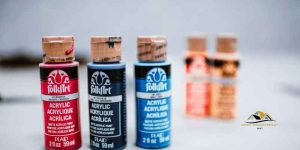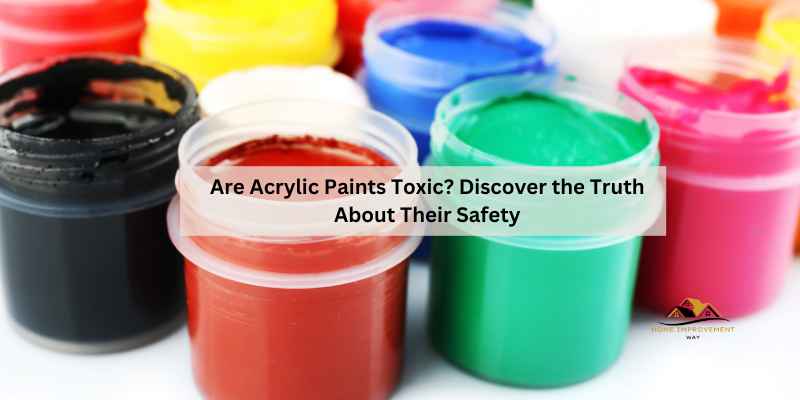Acrylic paints are generally safe to use, but can become toxic if used for airbrushing or ingested in large amounts. When used for typical painting purposes, they are not harmful.
Acrylic paints are a popular choice for artists given their versatility and vibrant colors. However, concerns about their potential toxicity may lead some to wonder if they are safe to use. We will explore the safety of acrylic paints, including potential risks and how to safely use them for art projects.
Additionally, we’ll discuss the measures to take when using acrylic paints around children and explore any potential health risks associated with their use. By the end of this article, you will have a comprehensive understanding of the safety measures and precautions when using acrylic paints.
Understanding Acrylic Paints
Acrylic paints are a popular choice among artists due to their versatility, quick drying time, and vibrant colors. However, it is essential to understand the composition and potential toxic chemicals present in these paints to ensure safe usage.
Overview Of Acrylic Paint Composition
Acrylic paints are made from pigments suspended in an acrylic polymer emulsion. The pigment provides the color, while the polymer acts as a binding agent, allowing the paint to adhere to various surfaces. Some acrylic paints may also contain additives such as fillers, stabilizers, and surfactants to enhance their properties.
Potential Toxic Chemicals In Acrylic Paints
It is crucial for artists to be aware of the potential toxic chemicals that may be present in certain acrylic paints. The presence of toxic substances can pose risks, especially during activities such as airbrushing or sanding, or in cases of accidental ingestion.
Common toxic chemicals found in acrylic paints include cadmium, cobalt, manganese, chromium, and lead. These substances may be labeled on the paint tubes, and artists should exercise caution when using paints containing these chemicals to minimize exposure.
Safety Measures For Acrylic Paints
When it comes to working with acrylic paints, it’s important to prioritize safety. While acrylic paints are generally safe to use, there are certain precautions you should take to ensure your well-being. In this article, we will discuss two essential safety measures for working with acrylic paints: proper ventilation while painting and the use of protective gear.
Proper Ventilation While Painting
When using acrylic paints, it is crucial to have proper ventilation in your workspace. Adequate ventilation helps to minimize the inhalation of fumes that may be emitted during the painting process. These fumes can cause irritation to the eyes, nose, and throat if inhaled for a prolonged period.
Here are some tips to ensure proper ventilation:
- Open windows and doors to allow fresh air circulation
- Use fans to improve air circulation in the room
- Consider using a dedicated exhaust fan or air purifier to remove any harmful fumes
- Work in a well-ventilated area, such as a studio or a properly ventilated garage
By following these ventilation measures, you can minimize the risk of inhaling any potentially harmful fumes while working with acrylic paints.
Use Of Protective Gear
An additional safety measure when working with acrylic paints is the use of protective gear. Protective gear helps to safeguard your skin, eyes, and respiratory system from any potential hazards that may arise during the painting process.
Here is the protective gear you should consider using:
- Wear disposable gloves to protect your skin from direct contact with the paint and any potentially harmful chemicals
- Use safety goggles or a face shield to shield your eyes from splatters or accidental contact with the paint
- Consider wearing a respiratory mask, especially if you are working with acrylic paints in an enclosed space or using airbrushing techniques
- Ensure that your workspace is equipped with a first aid kit in case of any minor accidents or injuries
By wearing the appropriate protective gear, you can create a safe working environment and prevent any potential harm to your body.
In conclusion, adopting safety measures such as proper ventilation and the use of protective gear is essential when working with acrylic paints. These precautions can help you minimize any potential risks and ensure your well-being while indulging in your artistic endeavors. Remember, prioritizing safety not only protects your health but also allows you to fully enjoy the creative process!
Health Implications
When it comes to using acrylic paints, it is important to be aware of the potential health implications. While acrylic paints are generally safe to use, it is crucial to understand the possible risks they carry.
Eye, Nose, And Throat Irritation
Acrylic paints contain small amounts of ammonia, which some individuals may be sensitive to. This can lead to irritation of the eyes, nose, and throat. It is important to work in a well-ventilated area and take breaks if you start to experience any discomfort.
Long-term Effects On Skin
Continuous exposure to acrylic paints can have long-term effects on the skin. Direct contact with these paints may cause dryness, itching, and even dermatitis in some individuals. It is crucial to protect your skin by wearing gloves and regularly moisturizing.
Impact On Artists
Acrylic paints are generally safe for artists, but certain precautions should be taken. While using them for typical painting purposes is not harmful, they can become toxic if used for airbrushing, sanded, or accidentally ingested in large amounts. Artists should be aware of potential risks and use them carefully to minimize any health concerns.
When it comes to the impact of acrylic paints on artists, it is essential to consider their potential toxicity. While acrylic paints are generally safe to use for typical painting purposes, it is crucial for artists to be aware of the potential risks involved. Understanding the impact of acrylic paints on professional artists is vital for their health and safety.
Professional Artists’ Perspectives
Professional artists have varying opinions on the toxicity of acrylic paints. Some artists believe that the small amounts of toxic chemicals present in certain acrylic colors, such as cadmium, cobalt, manganese, chromium, and lead, make them hesitant to use these specific colors. These artists prioritize their health and safety and opt for alternatives that are free from toxic substances.
On the other hand, other professional artists argue that the risks associated with acrylic paints are minimal as long as proper safety guidelines are followed. They emphasize that using acrylic paints for typical painting purposes, such as applying them with a brush to a canvas, does not pose significant health hazards. These artists believe that it’s crucial to focus on safe usage and take necessary precautions to minimize any potential risks.
Guidelines For Safe Usage
To ensure safe usage of acrylic paints, professional artists should adhere to the following guidelines:
- Work in a well-ventilated area or use an exhaust fan to minimize exposure to fumes.
- Use a mask or respirator to protect against inhalation of paint particles.
- Wear disposable gloves to prevent skin contact with the paint.
- Avoid ingesting paint by not eating, drinking, or smoking while working with acrylic paints.
- Properly dispose of any waste materials, such as used brushes, containers, or rags contaminated with paint.
By following these guidelines, professional artists can mitigate potential health risks associated with acrylic paints and continue pursuing their artistic endeavors safely.
Regulatory Standards
Labels On Toxic Acrylic Paints
Acrylic paints with toxic chemicals are clearly labeled with warnings for substances like cadmium, cobalt, manganese, chromium, and lead.
Comparison With Non-toxic Alternatives
- Non-toxic acrylic paints: Safe for typical painting purposes, pose minimal risk when ingested in small amounts.
- Non-toxic alternatives: Options like water-based acrylic paints, natural paints, or plant-based paints offer safer choices for artists.
Acrylic Paints In Educational Settings
Acrylic paints are generally safe in educational settings. However, if not used correctly, they can become toxic. Proper ventilation and supervision are essential to ensure a safe painting environment for students. Remember to check labels for toxic chemicals like cadmium, cobalt, and lead.
Safe Practices In Schools
- Provide proper ventilation in art classrooms to reduce exposure to fumes.
- Store acrylic paints in sealed containers away from food and drinks.
- Encourage students to wear aprons or protective clothing while painting.
Recommendations For Children
- Ensure children wash their hands thoroughly after using acrylic paints.
- Supervise young children to prevent ingestion of paint or paintbrushes.
- Choose acrylic paints labeled as “non-toxic” for child-friendly use.
Popular Myths Debunked
There are several misconceptions surrounding the toxicity of acrylic paints. Let’s explore and debunk some of the popular myths related to their potential harm.
Acrylic Paints And Carcinogenicity
One common myth regarding acrylic paints is that they are carcinogenic. It is often mistakenly believed that these paints contain harmful chemicals that can lead to cancer.
Misconceptions About Acrylic Paints
- Myth 1: Acrylic paints are considered toxic after they dry.
- Myth 2: All acrylic paints pose a health risk to children.
- Myth 3: Acrylic paints emit dangerous fumes when used indoors.
Let’s debunk these misconceptions one by one.

Frequently Asked Questions
Is Acrylic Paint Toxic To The Body?
Acrylic paint becomes toxic when inhaled during airbrushing or ingested in large amounts. When used for typical painting, they are safe.
Is Acrylic Paint Toxic After It Dries?
Acrylic paint is generally safe once dried. It can become toxic if used improperly, like when airbrushing.
Is Acrylic Paint Safe For Kids?
Acrylic paint is generally safe for kids when used for typical painting purposes. However, it can become toxic if used for airbrushing, when sanded, or if ingested in large amounts. It’s best to choose non-toxic paints for young kids.
Is It Safe To Use Acrylic Paint Indoors?
Acrylic paint is generally safe to use indoors, as long as you follow proper guidelines. It only becomes toxic if used for airbrushing, sanded, or ingested in large amounts. When used for typical acrylic painting purposes, such as applying with a brush to a canvas, it is not harmful.
Make sure to use proper ventilation and avoid direct contact with skin or eyes.
Conclusion
After reviewing the potential toxicity of acrylic paints, it’s clear that while they can pose risks in certain scenarios, such as airbrushing or ingestion, they are generally safe for typical painting purposes. By using them responsibly and following safety guidelines, artists and hobbyists can continue to enjoy the creative benefits of acrylic paints without significant health concerns.


